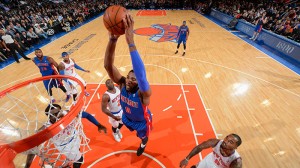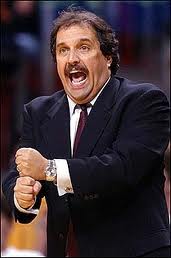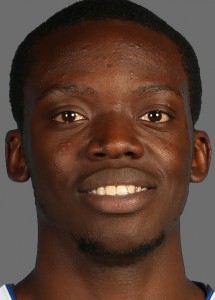 In 2014-15, the Detroit Pistons’ season broke down into three key sample sizes:
In 2014-15, the Detroit Pistons’ season broke down into three key sample sizes: 
1. Pre-Josh Smith buyout (Oct. 29-Dec. 22). Detroit went 5-23, was 28th in offensive rating (97.6) and 24th in defensive rating (105.8).
2. Post-Josh Smith buyout, pre-Brandon Jennings injury (Dec. 23-Feb. 19). Detroit did a virtual 180, going 16-10 with the sixth-ranked offensive rating (106.4) while improving their defensive rating to middle-of-the-pack status (15th, 101.9).
3. Post-Reggie Jackson acquisition (Feb. 20-April 15). The Pistons closed the season 11-17 and regressed to the mean with a 15th-ranked offensive rating (103.1) and 19th-ranked defensive rating (104.4).
Normally, this would be tough to experience for Pistons fans, especially when you factor in that Detroit hasn’t been above .500 since 2007-08 (181-295 in seven seasons), instantly making it even more miserable.
Yet, hope is on the horizon.
With an exciting young point guard, one of the best offensive rebounders in the league and a first-year small forward who has as good a shot as any to win Rookie of the Year, things are looking up for the moment.
Here are five things to watch with the Pistons this season.
1. What should we expect out of Stanley Johnson’s rookie season?
Stanley Johnson is one of the most mature and physically ready players in the draft, as our own Chris Sheridan noted thoroughly in a recent podcast:
What are the Pistons getting from the PAC-12 Player of the Year out of Arizona who won four consecutive state titles at Mater Dei HS in California before doing his one-and-done? How about a latter-day version of Ron Artest, without the craziness? Scouts and pro personnel folks believe Johnson has perhaps the most NBA-ready body of any of the incoming pros, and Johnson’s Rookie of the Year campaign will be helped by the fact that he should be able to move into the starting lineup fairly quickly — maybe even by Day One.
 The most impressive part about Johnson’s first three preseason games, though, is that he has shot 7-of-15 on 3-pointers. Moreover, Johnson has proven to be capable of scoring at all three levels. But he will have to work on his shot selection, as is the case with most rookies.
The most impressive part about Johnson’s first three preseason games, though, is that he has shot 7-of-15 on 3-pointers. Moreover, Johnson has proven to be capable of scoring at all three levels. But he will have to work on his shot selection, as is the case with most rookies.
Perimeter shooting was one of Johnson’s biggest question marks heading into the draft (doubling as a big-time need for Detroit from its 3-spot). If he can consistently knock down jumpers while also being a threat to drive or cut to the rim, he should help to space the court for the Reggie Jackson-Andre Drummond pick-and-roll to gain traction.
Speaking of the Jackson-Drummond pick-and roll…
2. Can Andre Drummond keep progressing, especially as an offensive weapon?
The first time I ever saw Andre Drummond play basketball was during the spring of his high school junior season at an AAU event in the Bronx. I watched most of the game, which he dominated. With the game firmly in hand, I walked across the gym to catch another game.
That’s when, from all the way across the gym, I saw Drummond dribbling the ball near half-court as the clock wound down. The defender pressed up. Drummond went behind the back, spun, protected the ball like a guard and exploded down the lane for a massive one-handed jam. (For convenience, the video starts at the move – and if you’re reading, it’s worth watching.)
What’s my point?
On the surface, Drummond’s 48 double-doubles last season (second in the NBA to Pau Gasol’s 54) are extremely impressive. The big man also averaged career highs of 13.8 points, 13.5 rebounds (second) and 1.9 blocks (tied for sixth).
But delve deeper and you can find so many reasons to sincerely believe that Drummond is just scratching the surface of his massive potential, especially at the offensive end. He can become a force in today’s pick-and-roll game.
How?
Think about this: Among players who took 100-plus shots as the roll man in the pick-and-roll, Drummond (68-of-104, .654 had the second-highest percentage in the NBA while averaging 1.18 points per possession (3rd).
When put into perspective from a volume point of view – beginning at Nikola Vucevic (319 shots) and ending with  Serge Ibaka (202 shots), the top nine players in shot attempts as the roll man took over 200 shots – it becomes clear that Drummond has the potential to offer much more offensively.
Serge Ibaka (202 shots), the top nine players in shot attempts as the roll man took over 200 shots – it becomes clear that Drummond has the potential to offer much more offensively.
Add that Drummond was third in percentage of points scored in the paint (86.2 percent) among players who played in at least 50 games last season and was also the most lethal offensive rebounder (league-leading 5.3 per game at 18.3 percent) and you have a player who is on the cusp of putting up some even more monstrous numbers.
To better visualize Drummond’s offensive interior presence, take a look at his shot chart from last season, when 889 of his 961 field goal attempts (92.5 percent) came within the restricted area:
There are a few variables that especially impact how effective Drummond may be on the interior this season and moving forward:
- How will the Jackson-Drummond connection continue to develop? Will Jackson strike the right balance between probing the defense, playmaking and aggressiveness as a scorer?
- Will Drummond’s ability to score around the rim – through fouls, around and over defenders – improve as he puts in more reps and gains experience over the years?
- Speaking of fouls: Can Drummond improve upon his horrifying career .397 mark from the stripe? If he ever gets to 60 or better it will help this team immensely.
- With Greg Monroe gone, will Stan Van Gundy provide the right type of personnel and floor spacing for Drummond’s interior skills to be maximized?
I’m not sure how far we will see Drummond progress at the offensive end this season. But with a player who is as agile and mobile as this 7-foot, 280-pounder, even a baby step forward could be a big deal for the Pistons.
 3. Will Stan Van Gundy utilize small ball as his primary weapon?
3. Will Stan Van Gundy utilize small ball as his primary weapon?
It is telling that the Pistons’ primary offseason pickup was Ersan Ilyasova, the stretch-4 acquired in a trade with the Bucks.
Dating to his earlier coaching days, we are acutely aware that SVG wants to play fast in transition, spread the floor, attack inside-out at times (if Drummond is capable) and – of course – shoot 3-pointers. Detroit fired 24.9 shots from the arc per game last season, 11th in the NBA.
In SVG’s inaugural season with Detroit, the lineup of Jennings, Kentavious Caldwell-Pope, Kyle Singler, Monroe and Drummond played a team-leading 254 minutes. The Monroe-Drummond pairing proved too futile too often for SVG to even entertain the thought of keeping them together, so Monroe bounced to Milwaukee via free agency.
We know that the Josh Smith situation, subsequent contract buyout and use of the stretch provision played a role in what lineups Van Gundy put on the court last season. We also know that one of the side effects of utilizing lineups with Monroe and Drummond together was that the Pistons allowed opponents to shoot 42.4 percent on 3-pointers, second-highest in the NBA.
With a potential lineup of Jackson, Caldwell-Pope, Marcus Morris, Ilyasova and Drummond – with Johnson, Anthony Tolliver, Jodie Meeks, Steve Blake and Spencer Dinwiddie available off the bench – Stan certainly has gotten closer to having a team that resembles today’s stretch-the-floor lineups.
And judging by the lack of big depth – Aron Baynes is the only other true big guaranteed to be on the roster, while Jordan Bachynski and Joel Anthony are fighting for a spot – it appears as though SVG will be living and dying by the three and small ball even more in 2015-16.
4. How will Reggie Jackson respond after getting paid?????????????
It is no secret that in many regards Reggie Jackson’s progress on the court might correlate to SVG’s job security in Detroit. Jackson’s newly minted five-year, $80 million contract was a signal of the current NBA landscape: A 25-year-old, hyper-athletic 6-3, 210 pound guard with the potential to be a real threat on both sides of the ball.
Jackson has shown flashes of his immense potential in spurts throughout his four-year career, first as a reserve and fill-in starting point guard for the Thunder and most recently as a starter in Detroit. But he has room to get better, and has to.
Despite starting just 40 games last season, Jackson finished 10th in the NBA in total points on drives (438, 49.9 percent ). The players in front of him were consistent starters.
). The players in front of him were consistent starters.
So, as incredible of a finisher as he is, how does Jackson take the next step as a lead guard?
For the Pistons to make real progress, Jackson has to be acutely aware of his shot selection. He has to take accountability for taking bad shots, learn from them and be better for it the next game. As the team’s point guard and primary ballhandler, Jackson must be a leader in terms of taking good shots so the rest of the team feeds off his shot selection.
Jackson shot just 35.3 percent on nearly seven pull-up jumpers per game in 27 games with Detroit, including 27.5 percent on nearly two pull-up threes. This was Jackson’s first real chance to start without looking over his shoulder, and it was on a team where he had to be the guy most of the time. That’s a challenging gig. And there were flashes of brilliance, too. His 23-point, 20 assist performance in a win against Memphis was eye-popping.
SVG is banking on surrounding Jackson with more talent and, as he develops as a playmaker, scorer and defender as a starter – that he will turn into a consistent lead guard who is challenging the upper echelon players nightly at his position. It is too early to know how this will turn out, but it is definitely worth watching.
5. Where does Brandon Jennings fit into the equation, if at all?
 On Jan. 21, Jennings scored 24 points with 21 dimes, becoming the first Piston in nearly 30 years with a 20-20 game with assists. Three nights later, Jennings went down with a ruptured Achilles tendon.
On Jan. 21, Jennings scored 24 points with 21 dimes, becoming the first Piston in nearly 30 years with a 20-20 game with assists. Three nights later, Jennings went down with a ruptured Achilles tendon.
Now, as a result of his injury, Jackson’s acquisition and contract, and Jennings entering the final year of his deal, it is no secret that Detroit will be shopping him for the next few months in the hopes of adding depth.
If Jennings makes a comeback with Detroit in December or January, Van Gundy would be wise to play him in a reserve role in hopes of increasing his stock before the trade deadline.
Jeremy Bauman works at the intersection of social media and basketball. He has an affinity for advanced statistics and how they correlate to on-court training and game situations. Follow him on Twitter here.
